- Details
-
Published: Monday, 02 February 2015 21:05
-
Written by Michael Halligan
Torre Canela
Torre Isla Canela is located on Isla Canela road that brings you to Punta del Moral and Isla Canela Marina.
The tower, like many along the Andalucian coast mainly from Gibraltar to Ayamonte, was commissioned by Felipe II in late 1500s to protect the coast from attacks by Turkish and Berber pirates.
Felipe II ordered more than 40 of these beacon-shaped towers to be built, although the cost often fell back on the local population.
The towers were eventually paid for by a Sisa del pescado, a type of fishing tax which was levied at one maravedi (one thirty-fourth part of a real) for every pound of fish caught.
Some of the towers never got off the drawing board as the local councils were unable to raise the funds or there was strong opposition to the tax and the positioning of the tower.
The tower had fallen into disrepair and although Isla Canela (Pryconsa) did some renovation work on the tower in the 90’s it wasn’t until 2010 that a full restoration project was completed with funding from the Junta de Andalucía.{rokbox title=|See Torre Canela Restoration Video Here| size=|854 505| album=|demo|}http://www.youtube.com/watch?v=nqG8QvhsQIo{/rokbox}
Ana María Mateos Gómez, an architect from Ayamonte, and her colleague Manuel Gonzalez Martinez, a quantity surveyor, started to study the renovation of Torre Canela in 2005.
It was their preliminary study of the tower which led to an interesting discovery and a change in the restoration plan for Torre Canela.
On the first investigation of the site and the tower’s roof the architect and surveyor noticed that the floor on the roof was sloping outwards to evacuate any water that fell. Under normal circumstances you would expect this to be correct but this was a defense tower and they were usually designed with the roof sloping inwards to collect the water to be used later by the guards who stayed in these towers. This only spurred both Manuel and Ana on to find out what was the reason behind this anomaly.
What followed was a petition to the Junta de Andalucía to bring some archaeologists to the tower and open a section in the floor to confirm the suspicion. The well that was found at the centre of the tower is now a feature for everyone to see when they visit the Tower. The floor of the tower is a stainless steel grid and below behind glass you can view the well.
The tower, which had two chambers, had deteriorated over time and a wooden vault structure was built to simulate how the two chambers were originally.
The two chambers are now connected via a stairwell and a stainless steel banister with glass panels around the edge of the wooden vault prevents visitors from falling down into the tower.
Sadly Canela Tower does not yet have a set timetable for viewing so it is best to ask in the Tourism Office in Ayamonte for opening hours. It is expected to be used as an exhibition centre in the future.
- Details
-
Published: Monday, 02 February 2015 20:59
-
Written by Michael Halligan
La Casa Grande
"Ayamonte's Art gallery and much more"
The Casa Grande situated on Calle Huelva in front of the Plaza de Rosario in Ayamonte was built in 1745 for Manuel Rivero González (El Pintado) and his wife Juana Inocencio Díaz.
The fascade is made of oyster stone, an expensive building material which is more common in Cadiz. As Manuel Rivero was a wealthy trader and had ships in Cadiz , it was these ships that brought the oyster stone to Ayamonte both for use in the building of the Casa Grande and in the Mill (see Ecomuseum El Pintado).
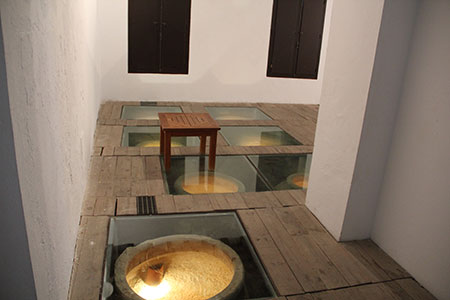 The house (casa) is built around a central patio which is surrounded by marble pillars and decorated arches. It fell into disrepair in the early 20th Century but the Town hall later bought the property and has restored it to its former glory. It now serves as the cultural centre for the town. On the ground floor there is a gallery which has been the site of many itinerary exhibitions over the last few years.
The house (casa) is built around a central patio which is surrounded by marble pillars and decorated arches. It fell into disrepair in the early 20th Century but the Town hall later bought the property and has restored it to its former glory. It now serves as the cultural centre for the town. On the ground floor there is a gallery which has been the site of many itinerary exhibitions over the last few years.
On entering the Casa Grande you can walk straight into the patio and to your left is the stairs which brings you to the Jiménez Barberi Municipal library on the first floor. Also on your left is a gallery which has a wooden and glass floor with huge amphoras, just like the ones El Pintado (the marked one) used while trading with the Americas.
Depending on the time of year the doors to the external patio, which in recent years was refurbished with Portuguese calcada, are open. Take a stroll out and have a look at the landscape tiles by local ceramic artist Joaquin de la Pascua
On the first floor there is a wide variety of paintings by local artists on show and it also houses some visiting exhibitions. It is always worth a visit as there is always something new to see and also to see the posters that have been used in Ayamonte’s famous carnivals.
The Casa Grande has a theatre (seats approximately 250 people) which is often used for presentations or the projection of films.
The Casa Grande is open Monday to Friday 09.00 – 14.00 & 16.30 – 21.30, Saturdays 09.30 – 14.30.
https://www.youtube.com/watch?v=3PxzP4GPkx4
- Details
-
Published: Monday, 02 February 2015 21:08
-
Written by Michael Halligan
Eco-Museum Molino el Pintado
Ayamonte’s eco-museum Molino el Pintado officially opened its doors in 2009 after a complete restoration of the mill which was a ruin until the Coastal Authorities funded the rebuild to the tune of 653,000 euros.
The Junta de Andalucia completed the fitting out of the mill as an eco-museum, thanks to an agreement reached with the Environment Department and Ayamonte Town Hall.
This Mill or should I say Eco-Museum was one of the most important tidal mills along this coast and it has had its ups and downs over the centuries.{rokbox title=|See Molino El Pintado Video Here| size=|854 505| album=|demo|}http://www.youtube.com/watch?v=mjoeY6j0Gm8{/rokbox}
Manuel Rivero Gonzaléz, El Pintado, the person who the Museum was named after, first restored this mill to its former glory in the 18th century. By the way El Pintado ( the marked one)nickname El Pintado comes from the marks left on Manuel Rivero’s body after he came down with the smallpox. Manuel Rivero who came from a modest background built up trade connections with the Americas and became a wealthy trader. On marrying Juana Inocenio Díaz Cordero (Ayamontina) they together built an empire based around their life in Ayamonte. And many of the important buildings like the Casa Grande and pieces of art belonging to the town were donated by the Rivero family.
The Mill itself also benefited from Manuel Rivero’s trading links, with his ships bringing in Oyster stone from Cadiz to restore the Mill. This stone can be clearly seen as you enter the first section of the Eco-museum, it was an expensive building material at the time but once again highlights the generousity of Manuel Rivero “El Pintado”.
The mill itself had six different milling stones which were manned by a single person, with the front area of the mill serving as the living quarters for the miller’s family.
The museum not only gives the history behind the building of the mill and the Rivero family but it also goes into detail about how these marshlands were formed.
As you enter the museum you can see how the Isla Cristina marshlands came about, there are detailed diagrams on the formation as well as samples of each section of the formation.
The museum has the latest audio visual technology and visitors are given special headphones which are automatically activated by infrared as you enter each area.
“Unlike before, where you had to press a number, here you just walk into the exhibition area and the audio guide will start up for that specific area. The only thing the visitor needs to control is the volume on his or her unit.
The second area of the museum shows how the marshlands provided a way of living for the local people, from the salt flats (see more here) to fishing.
It also shows how many species now live in this protected park, everything from mallard to black headed gulls. The marshlands, which cover an area of 2,145 hectares, were declared a national park in 1989.
The main hall in the museum is where you can see the internal working of a mill and all the tools that were used to keep the mill running.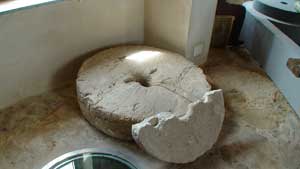
The mill itself produced flour which was shipped from Ayamonte on boats along with all the other produce which the Rivero family sold around the world. Fruit and flour were the two main cargos shipped from the mill here in Ayamonte.
The eco-museum Molino el Pintado is open Tuesday to Friday, 10 am to 2pm and 4pm to 6pm. Admission is free.
- Details
-
Published: Monday, 02 February 2015 21:10
-
Written by Michael Halligan
Salt Flats
"All the good with a pinch of spice"
In Huelva and Cadiz we are surrounded by national parks. These parks which are not only set in the mountains and woodlands also take up vast tracts of land along the coastline. It is in these parks that many of the traditional salt flats are located. By using the word traditional here I am excluding all the salt flats where salt is harvested using machinery. It is great to see the centuries old methods of harvesting salt still surviving today and they will survive for years to come simply down to the superior quality their products have to offer.
Of course I am no expert in this matter but I have Rosario Gómez Santana and Francisco Castillo Rodriguez owner of “Flor de Sal” traditional salt flats in Isla Cristina to steer me in the right direction and bring you all into this world of salt. The whole system of the salt flats has it own language and methods and Francisco who has spent nearly all his life harvesting salt from the salt flats is going to explain how it all works.
All of you have taken a dip in the Atlantic Ocean know that it is a good bit colder than the adjoining Mediterranean but at the same time it is a lot cleaner.
Francisco explains that the water that flows in from the sea is normally four or five degrees Celsius, this water flows into a pool called “Estero”, marsh. Here the water warms up to approximately seven degrees and then is let flow into areas called “sifones” , funnels. The water warms up to about 10 degrees Celsius and from here is passed on to the “calentadores” heating pools where the sun takes the water up to 15-16 degrees Celsius. The water then passes into the “corridor or tajo” corridor or stream around the evaporation pools where it reaches the ideal temperature of 25 degrees Celsius before the “Ojal” (a hole in the evaporation pool wall) is opened with a stick to fill the evaporation pool. When the water reaches 27 degrees Celsius in the evaporation pools salt crystal form and the harvest of salt can truly begin.
There are five different types of salt that can be harvested and although it is Francisco and his hardy workers that harvest the salt, it is Rosario who explained the how they harvest each type and the different qualities each of these different salts offer:
Flor de Sal
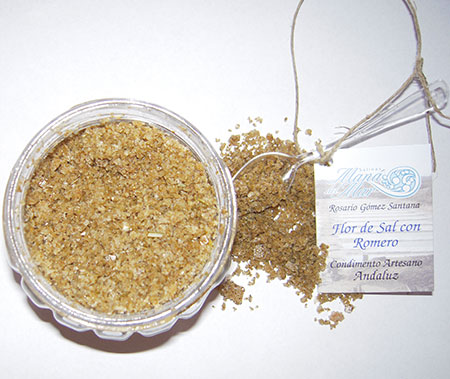 The salt crystals which form on the surface of the water in the evaporation ponds are called Flor de Sal, Flower of salt. It is harvested off the top of the water when the salt crystals form, usually in the hot summer afternoons. “This salt is the highest quality salt we have and it is used to give that final taste to your dishes and also in cold sauces. It is pure white with a smooth texture but a crunchy taste and only the traditional salt flats offer this type of salt. It has less sodium and is rich in magnesium, calcium, fluorine and iodine. All this minerals are what your body needs to keep a good balance. Of course taken in correct amounts like everything else” said Rosario.
The salt crystals which form on the surface of the water in the evaporation ponds are called Flor de Sal, Flower of salt. It is harvested off the top of the water when the salt crystals form, usually in the hot summer afternoons. “This salt is the highest quality salt we have and it is used to give that final taste to your dishes and also in cold sauces. It is pure white with a smooth texture but a crunchy taste and only the traditional salt flats offer this type of salt. It has less sodium and is rich in magnesium, calcium, fluorine and iodine. All this minerals are what your body needs to keep a good balance. Of course taken in correct amounts like everything else” said Rosario.
Salt Pyramids
The flor de sal which is not skimmed off the surface before nightfall is left for the next morning and harvested in the form of crystals in the shape of pyramids. The salt has nearly all the same qualities as the flor de sal only that it doesn’t dissolve as quickly.
Hojas de sal/ Salt flakes
Hojas de sal or salt flakes are suspended in the water and are harvested using a fine net attached to a poll similar to those used when cleaning a pool. “ This salt is used for cooking fish, meat and many other food and has a stronger taste than the previous two salts, it absorbs some of the juices from the food being cooked” said Rosario
Espuma de sal/ salt foam
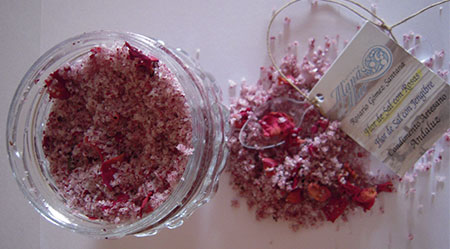 This salt is a mixture between salt flakes and flor de sal and it builds up in the corners of the evaporation ponds on windy days. “We don’t harvest a lot of this salt but it is great for cooking” said Rosario
This salt is a mixture between salt flakes and flor de sal and it builds up in the corners of the evaporation ponds on windy days. “We don’t harvest a lot of this salt but it is great for cooking” said Rosario
Sal gordo / cooking salt
This salt is raked from the base of the evaporation ponds using a “roll” a long poll with a flat plank attached vertically to one end. “This salt is humid and has magnesium which is important for the central nervous system and it has numerous uses. For swimming pools, relaxing baths, curing ham, all types of salting” said Rosario.
Seeing the salt been harvested is a sight unto itself but the crunching sound as the salt is harvested is like nothing I have ever heard before. The next time you are near a salt flat in the summer I strongly recommend you take time to visit. Rosario also prepares flor de sal with special herbs and spices and there is even one with rose petals. She also gave me a great tip for keeping the colour in your coloured clothes: a handful of cooking sal in the drum before the wash.
On a final note for all of you out there who like salt but the doctor has told you to cut back, get some Flor de sal. If you are going to keep using salt this is by far the healthiest option. My Spanish mother in law highly recommends it and of course she also recommends Lyons Irish green tea.
- Details
-
Published: Saturday, 16 March 2013 22:23
-
Written by Michael Halligan

The Ayamonte’s Association for Brotherhoods (Agrupación de Cofradías y Hermandades de Ayamonte) was founded on 10th February 1941 with the intention of bringing all the brotherhoods together to help make the Semana Santa processions even better.
The museum is in the brotherhoods headquarters which on Calle Jovellanos right beside the Mercedes Temple. It occupies the whole of the top floor and you access it by going up a marble stairs from the interior patio.
History
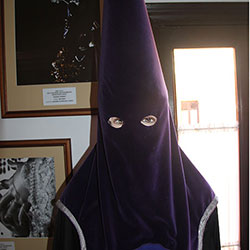 The building itself dates back to 1640 and was built by Diego Pérez Mestre and over the centuries has been used for many different services from convent to maritime school and it wasn’t until April 2002 that it was handed over to the Ayamonte’s Association for Brotherhoods by the Town Hall. A year later on April 12th 2003 the museum of over 500 square metres was opened to the public.
The building itself dates back to 1640 and was built by Diego Pérez Mestre and over the centuries has been used for many different services from convent to maritime school and it wasn’t until April 2002 that it was handed over to the Ayamonte’s Association for Brotherhoods by the Town Hall. A year later on April 12th 2003 the museum of over 500 square metres was opened to the public.
Once you enter the museum you see a corridor which goes around the whole of the patio and the walls are lined with the posters of all the Semana Santas since they started doing posters which was in early 1940’s. Then as you reach the end of the corridor you will see photos of Semana Santa, many being winning photos of the photo competition that the Association runs every year.
Clothing / attire
If you know nothing about Semana Santa or the style of clothing that is worn by the people who take part in the processions, you are in for a real surprise. The attire is something akin to what the Klu Klux Klan wore and the mannequins which are spread around the corridor can be quiet intimidating. The eyes staring out at you from behind the capirote (this cone shaped hood) gets me every time.
Each of the nine brotherhoods has their own attire and all of them are represented in the museum. Of course seeing them on the street is by far the best but if you cannot make it to Ayamonte during Semana Santa it gives you a good insight as to what goes on.(Also see the the semana santa video)
Exhibit Hall / La Sala de Exposiciones
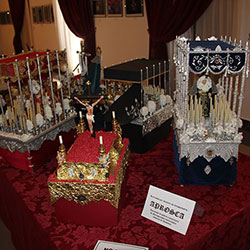 While the whole museum is an exhibit, the exhibit hall houses itinerant exhibitions from time to time and has thrown up many pleasant surprises over the various occasions I have visited the museum. The most memorable being an exhibition of Semana Santa where the thrones that are carried around the town during Semana Santa were all made in miniature by APROSCA a local association of parents and protectors of Children and adults with intellectual disabilities.
While the whole museum is an exhibit, the exhibit hall houses itinerant exhibitions from time to time and has thrown up many pleasant surprises over the various occasions I have visited the museum. The most memorable being an exhibition of Semana Santa where the thrones that are carried around the town during Semana Santa were all made in miniature by APROSCA a local association of parents and protectors of Children and adults with intellectual disabilities.
Meeting Room / Sala de Juntas
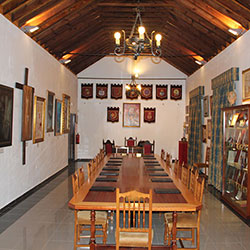 This Sala de Juntas located at the end of the corridor on the right is where the heads of all the brotherhoods meet and where the original painting of the Semana Santa are hung. A little over 75 square metres with a large rectangular table in the centre, with the walls covered in paintings, shields, and medals. Make sure you see this room as it’s worth the visit, sometimes it is locked so just ask the caretaker to open it up so you can see.
This Sala de Juntas located at the end of the corridor on the right is where the heads of all the brotherhoods meet and where the original painting of the Semana Santa are hung. A little over 75 square metres with a large rectangular table in the centre, with the walls covered in paintings, shields, and medals. Make sure you see this room as it’s worth the visit, sometimes it is locked so just ask the caretaker to open it up so you can see.
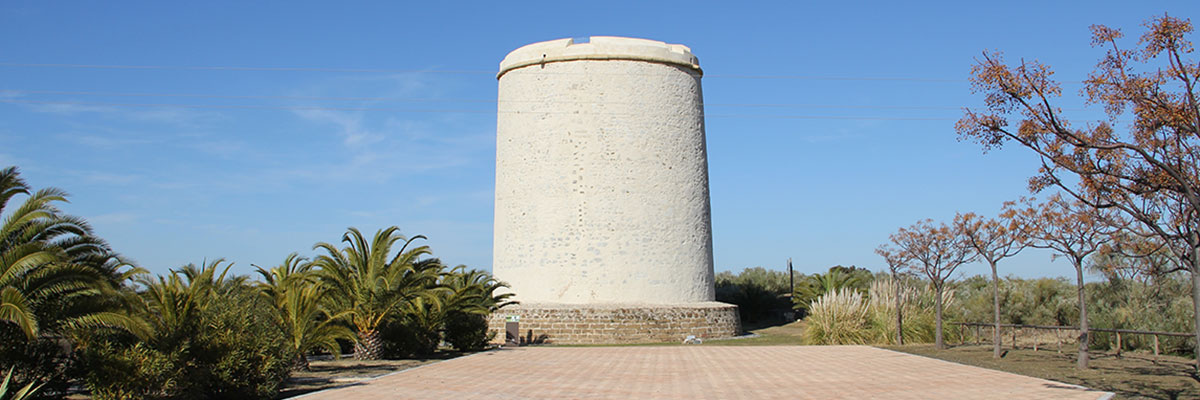

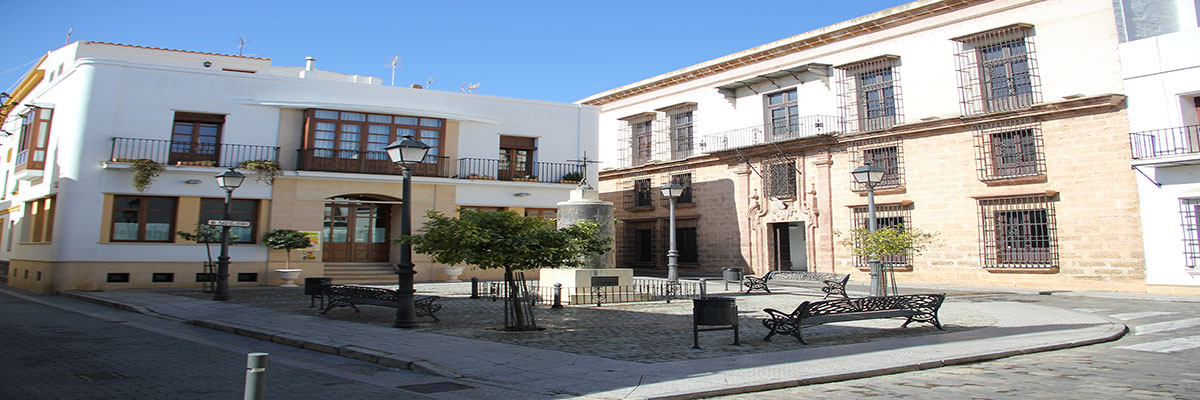
 The house (casa) is built around a central patio which is surrounded by marble pillars and decorated arches. It fell into disrepair in the early 20th Century but the Town hall later bought the property and has restored it to its former glory. It now serves as the cultural centre for the town. On the ground floor there is a gallery which has been the site of many itinerary exhibitions over the last few years.
The house (casa) is built around a central patio which is surrounded by marble pillars and decorated arches. It fell into disrepair in the early 20th Century but the Town hall later bought the property and has restored it to its former glory. It now serves as the cultural centre for the town. On the ground floor there is a gallery which has been the site of many itinerary exhibitions over the last few years.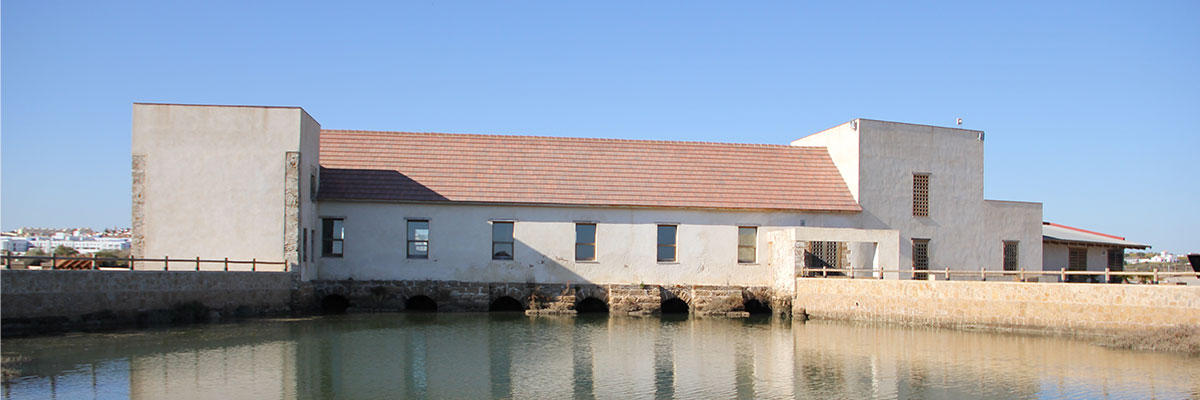


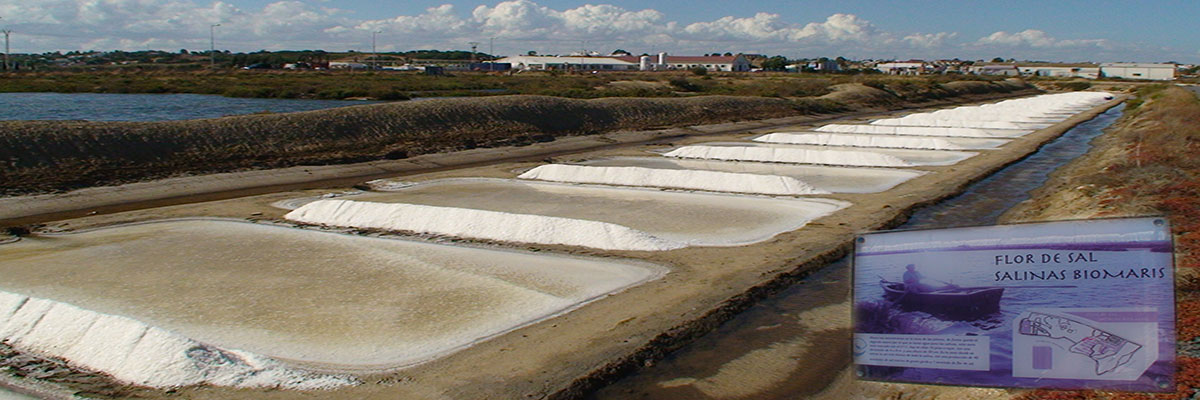
 The salt crystals which form on the surface of the water in the evaporation ponds are called Flor de Sal, Flower of salt. It is harvested off the top of the water when the salt crystals form, usually in the hot summer afternoons. “This salt is the highest quality salt we have and it is used to give that final taste to your dishes and also in cold sauces. It is pure white with a smooth texture but a crunchy taste and only the traditional salt flats offer this type of salt. It has less sodium and is rich in magnesium, calcium, fluorine and iodine. All this minerals are what your body needs to keep a good balance. Of course taken in correct amounts like everything else” said Rosario.
The salt crystals which form on the surface of the water in the evaporation ponds are called Flor de Sal, Flower of salt. It is harvested off the top of the water when the salt crystals form, usually in the hot summer afternoons. “This salt is the highest quality salt we have and it is used to give that final taste to your dishes and also in cold sauces. It is pure white with a smooth texture but a crunchy taste and only the traditional salt flats offer this type of salt. It has less sodium and is rich in magnesium, calcium, fluorine and iodine. All this minerals are what your body needs to keep a good balance. Of course taken in correct amounts like everything else” said Rosario. This salt is a mixture between salt flakes and flor de sal and it builds up in the corners of the evaporation ponds on windy days. “We don’t harvest a lot of this salt but it is great for cooking” said Rosario
This salt is a mixture between salt flakes and flor de sal and it builds up in the corners of the evaporation ponds on windy days. “We don’t harvest a lot of this salt but it is great for cooking” said Rosario
 The building itself dates back to 1640 and was built by Diego Pérez Mestre and over the centuries has been used for many different services from convent to maritime school and it wasn’t until April 2002 that it was handed over to the Ayamonte’s Association for Brotherhoods by the Town Hall. A year later on April 12th 2003 the museum of over 500 square metres was opened to the public.
The building itself dates back to 1640 and was built by Diego Pérez Mestre and over the centuries has been used for many different services from convent to maritime school and it wasn’t until April 2002 that it was handed over to the Ayamonte’s Association for Brotherhoods by the Town Hall. A year later on April 12th 2003 the museum of over 500 square metres was opened to the public. While the whole museum is an exhibit, the exhibit hall houses itinerant exhibitions from time to time and has thrown up many pleasant surprises over the various occasions I have visited the museum. The most memorable being an exhibition of Semana Santa where the thrones that are carried around the town during Semana Santa were all made in miniature by APROSCA a local association of parents and protectors of Children and adults with intellectual disabilities.
While the whole museum is an exhibit, the exhibit hall houses itinerant exhibitions from time to time and has thrown up many pleasant surprises over the various occasions I have visited the museum. The most memorable being an exhibition of Semana Santa where the thrones that are carried around the town during Semana Santa were all made in miniature by APROSCA a local association of parents and protectors of Children and adults with intellectual disabilities. This Sala de Juntas located at the end of the corridor on the right is where the heads of all the brotherhoods meet and where the original painting of the Semana Santa are hung. A little over 75 square metres with a large rectangular table in the centre, with the walls covered in paintings, shields, and medals. Make sure you see this room as it’s worth the visit, sometimes it is locked so just ask the caretaker to open it up so you can see.
This Sala de Juntas located at the end of the corridor on the right is where the heads of all the brotherhoods meet and where the original painting of the Semana Santa are hung. A little over 75 square metres with a large rectangular table in the centre, with the walls covered in paintings, shields, and medals. Make sure you see this room as it’s worth the visit, sometimes it is locked so just ask the caretaker to open it up so you can see.